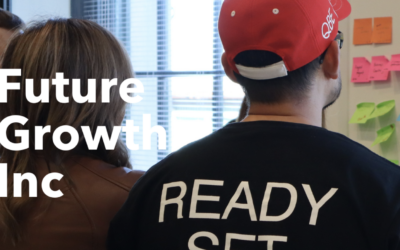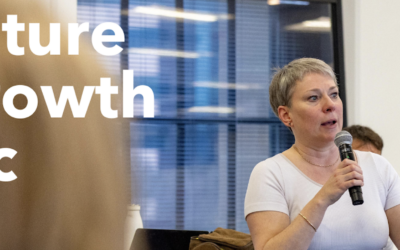Almost anywhere, and everywhere we look, there are powerful forces driving change in our cultural, social and technological landscapes. These forces often start as undercurrents, until, building in energy and momentum, they break through the veneer of business or “life” as usual — to announce themselves into our worlds.
It’s as if these disruptions are unexpected — and yet — for all the surprise they generate — they are also easily recognised. The new world looks very much like the old world. Just amplified. Inverted. Strangely familiar and unfamiliar at the same time.
Yet, if we look closely at our industries, businesses — or the artistic and cultural practices that underlie the cities and communities that we live in — disruption is never very far from the surface. This, perhaps, accounts for our unease or sense of impending change.
Identifying disruption
Despite the anxiety that accompanies “disruption”, there are very real and tangible steps we can take to identify when — and sometimes where — disruptive innovation may take place.
- New Expertise: One of the first bastions to fall in a time of disruption is the traditional “expert”. As disruption begins to take hold, new voices and viewpoints begin to emerge to assert a new form of knowledge and insight.
- New Organisations: When disruption begins to be felt within our populations, new organisations begin to emerge to deal with the social, cultural and political changes taking place.
- New Forms of Identity and Community: In the search for belonging and solidarity, groups and individuals work to develop new ways of recognising each other. New approaches to identity and community step out of the shadows of society’s underbelly to walk in the light of disruption.
- New Language and Conversations: With the old paradigms under increasing pressure, new forms and modes of language emerge to shape and communicate our present and near term futures. This language incorporates new meanings and insights while generating cultural velocity as it takes hold in conversations — on and offline.
- New Approaches to Education: With an eye on the future, educators feel the pressure to move with the expectations of industry players and the next generation of students, creating new structures, awards and curriculum to pave the way to this disruptive future.
Technology in Search of the Human and the Trust Paradox
Looking around the contemporary world, we can see that these elements are each in full swing across a series of industries. At first glance, this list of “new news” describes our current world — but surprisingly, this is not new. Not now. The list comes from Elizabeth Eisenstein’s work on the invention of the printing press. She is describing the challenges that have actually been underway for hundreds of years — but are again cycling through our contemporary moment with a new flavour and velocity.
In technology, the pendulum seems to have reversed direction, challenging us to not only embrace innovation, data, machine learning and artificial intelligence (and so much more), but to question its dominance.
Up until recently, the popular technology narrative focused on “the singularity” — the hypothesis that artificial intelligence powered by ever more powerful computers will trigger explosive technological growth leading to unimagined changes to human civilisation.
But disruption is on the rise and our intuitive, “spidey senses” are tingling. It now seems that our expected futures are no longer wholly determined by technology, but deeply rooted in our sense of humanity, trust and integrity. This is reflected in recent high profile disruptions like the scandal around data firm Cambridge Analytica and their use of/access to Facebook social graph data. Clearly the Facebook public did not quite understand the terms of the Trust Paradox and the bargain they had entered into with their use of the world’s largest social network.
Technology is being asked, in a word, to become more human.
Social Media, Me Too and Reconciliation
This shift is also reflected in the Me Too movement. Stepping out of the streams of social media that have proven such a powerful amplifier around the cause, Me Too founder, Tarana Burke, reminds us that the decade long movement has a focus not on men and the crimes that they have perpetrated, but on:
“What can I do, how can I heal, what’s possible for me, and so if we keep talking about the accused, the perpetrator, the men and what they lost, we lose sight of the people, the human beings.”
It is in the interplay between data, power and humanity where new bargains must be struck — and it seems that the old norms and forms of bargains and contracts — a social compact if you will — are requiring exploration.
When Sexuality and Technology Come Together
At a very fundamental level — the interplay between sex and technology — new conversations and practices are also emerging. Visionary founder of the Future of Sex, Bryony Cole, is exploring this highly contested space, focusing beyond the obvious categories of leisure, pleasure and porn, explaining:
The ramifications of creating an unspoken culture around sex is that critical information on protection and health is also ignored or driven underground. When shame and stigma prevent us from updating education or addressing the impact or ethics of new technology, the effects ripple out across individual health, and then more broadly across populations and economies.
The real world reality of this is reflected in everything from a nation’s birth rate to crime and violence statistics.
One of the new forms of exploration being pioneered is the “Sextech Hackathon”. The hackathon is traditionally a method to bring technical developer communities together to create and share knowledge, build networks and develop solutions to technical challenges. The Sextech Hackathons disrupt this form to:
- Create pathways for people of all backgrounds and genders and encouraging more diverse voices to be a part of the burgeoning sextech industry.
- Create opportunities to be part of a future leadership on sexual health and education at a local level.
These Sextech Hackathons are literally combining sex and tech in new ways with human experience at their heart. They are creating new expertise and thought leaders, organisations, public and private conversations, languages and cultural norms and even new university level disciplines and practices.
Where will human centred disruptive innovation lead?
The future — as always — remains unclear. But the direction is firm. The question is not where will disruptive innovation lead, but whether we — and our organisations — are curious enough to explore the pathways ahead. There’ll always be opportunities if you know where to look.



